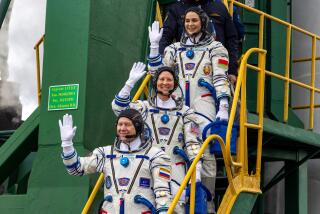Workers Cheer as Shuttle Gains Power
- Share via
KENNEDY SPACE CENTER, Fla. — Electricity surged into the shuttle Discovery on Monday as the space agency began readying the ship for the first post-Challenger flight, and an official said the powering-up showed that Americans have not “lost our will to fly men in space.”
Workers clapped and cheered as the power surged into the spacecraft and a sign flashed “Vehicle Powered” in the hangar where Discovery is being groomed.
“Significantly, we have reached our first milestone here in returning the shuttle fleet to flight status,” launch director Robert B. Sieck told reporters.
“It’s a great boost for morale, and gives us confidence that the road map we have laid out for return to launch is makable,” said John Talone, the Discovery flow director.
“The morale increase is noticeable as people get back to doing what they do best--preparing a vehicle for launch,” Talone said.
“The charge that we have lost our will to fly men in space is wrong,” Sieck said, countering an assertion made last week by Reginald Turnill, editor of the British publication Jane’s Spaceflight Directory, in the 1987 edition.
The three remaining shuttles have been grounded since Challenger exploded 73 seconds after launch on Jan. 28, 1986, killing all seven crew members.
The National Aeronautics and Space Administration has set a target date for launch of June 2, 1988, although some NASA officials privately question whether that date is realistic and think it may miss by two or three months. Until the latest date was set in May, NASA had been firmly predicting launch on Feb. 26, 1988.
Meeting a date set last January, engineers Monday switched on Discovery’s power for the first time in more than a year, verifying the electrical system.
Workers then turned on cooling systems and began a systematic check of the shuttle’s instrumentation, communications, radar and other systems.
For several months now, Discovery has undergone modifications to many of its systems. Most are designed to make the shuttle a safer vehicle in the wake of the Challenger disaster; others had been planned before the accident.
John Hallmark, Discovery’s lead engineer, said 84 of 190 planned modifications have been completed, with the remainder to be done during the flight processing.
For the next five weeks, the finished modifications will be tested before normal processing for launching, which is scheduled to begin in September.
More to Read
Sign up for Essential California
The most important California stories and recommendations in your inbox every morning.
You may occasionally receive promotional content from the Los Angeles Times.










